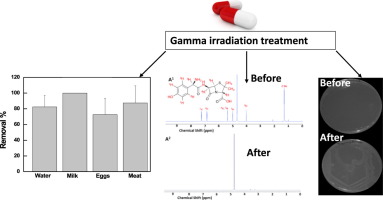Chemical Engineering Journal ( IF 13.3 ) Pub Date : 2018-01-12 , DOI: 10.1016/j.cej.2018.01.065 Omar A. Alsager , Mohammed N. Alnajrani , Othman Alhazzaa

|
Veterinary antibiotics are widely used to treat and prevent diseases and are also incorporated into animal feed to improve growth rate and production efficiency. There is growing concern regarding the potential impact of antibiotic residues on the environment and human health by leading to increased antibiotic resistance of microorganisms and negative influence on human by triggering allergic reactions. In this study, we investigated the destruction of commonly used veterinary antibiotics in water and various food commodities by ionizing gamma irradiation. We began by thoroughly investigating the decomposition of Amoxicillin, Doxycycline, and Ciprofloxacin in water at an initial concentration of 50 µM. All investigated compounds follow pseudo-first-order kinetics and the removal reached at least 90% at an absorbed dose of 7 kGy. This absorbed dose was applied to study the antimicrobial activity of the resulting decomposition solutions, by performing E. coli antimicrobial experiments. The application of 7 kGy resulted in a complete removal of the activity of the target antibiotics. In fact, 1H NMR and TOC experiments indicated that a complete mineralization of the target antibiotics is achieved at 7 kGy. The investigation was extended to evaluate the effectiveness of gamma irradiation in removing antibiotics from more complex matrices such as milk, chicken meat, and eggs. Overall, comparable antibiotic removal percentages were achieved in the studied food samples compared to those in water samples. Our study provides a practical solution to the growing concern of the presence of antibiotic residues in water and food. Well-established ionizing radiation technologies, such as high-energy electron beam, can be applied to remove antibiotic residues from bulk food products as well as water bodies.
中文翻译:

通过γ射线辐照分解抗生素:动力学,抗菌活性以及在食品基质中的实际应用
兽用抗生素被广泛用于治疗和预防疾病,还被掺入动物饲料中以提高生长速度和生产效率。人们越来越关注抗生素残留物对环境和人类健康的潜在影响,这会导致微生物对抗生素的耐药性增加,并通过引发过敏反应而对人类产生负面影响。在这项研究中,我们研究了通过电离伽马射线对水和各种食品中常用的兽用抗生素的破坏。我们从彻底研究初始浓度为50 µM的水中阿莫西林,强力霉素和环丙沙星的分解开始。所有研究的化合物均遵循拟一级动力学,在吸收剂量为7 kGy时,去除率至少达到90%。大肠杆菌抗菌实验。7 kGy的使用导致目标抗生素活性的完全消除。其实11 H NMR和TOC实验表明,在7 kGy时可实现目标抗生素的完全矿化。这项研究已扩展到评估伽马射线辐射从更复杂的基质(如牛奶,鸡肉和鸡蛋)中去除抗生素的有效性。总体而言,与水样品相比,研究食品样品中的抗生素去除率相当。我们的研究为水和食物中抗生素残留物的日益增长的关注提供了一种实用的解决方案。成熟的电离辐射技术,例如高能电子束,可用于去除散装食品和水体中的抗生素残留。











































 京公网安备 11010802027423号
京公网安备 11010802027423号